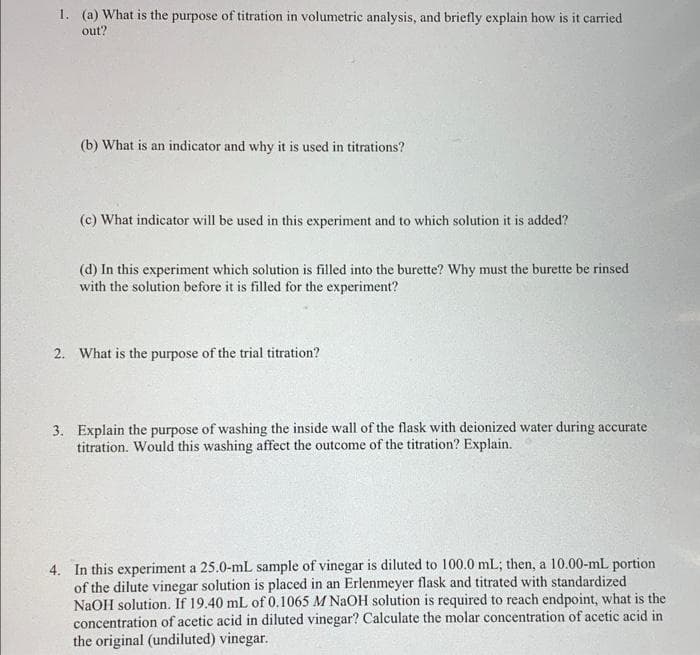1. (a) What is the purpose of titration in volumetric analysis, and briefly explain how is it carried out? (b) What is an indicator and why it is used in titrations? (c) What indicator will be used in this experiment and to which solution it is added?
1. (a) What is the purpose of titration in volumetric analysis, and briefly explain how is it carried out? (b) What is an indicator and why it is used in titrations? (c) What indicator will be used in this experiment and to which solution it is added?
Chemistry: Principles and Reactions
8th Edition
ISBN:9781305079373
Author:William L. Masterton, Cecile N. Hurley
Publisher:William L. Masterton, Cecile N. Hurley
Chapter10: Solutions
Section: Chapter Questions
Problem 65QAP: Twenty-five milliliters of a solution (d=1.107g/mL)containing 15.25% by mass of sulfuric acid is...
Related questions
Question
100%

Transcribed Image Text:1. (a) What is the purpose of titration in volumetric analysis, and briefly explain how is it carried
out?
(b) What is an indicator and why it is used in titrations?
(c) What indicator will be used in this experiment and to which solution it is added?
(d) In this experiment which solution is filled into the burette? Why must the burette be rinsed
with the solution before it is filled for the experiment?
2. What is the purpose of the trial titration?
3. Explain the purpose of washing the inside wall of the flask with deionized water during accurate
titration. Would this washing affect the outcome of the titration? Explain.
4. In this experiment a 25.0-mL sample of vinegar is diluted to 100.0 mL; then, a 10.00-mL portion
of the dilute vinegar solution is placed in an Erlenmeyer flask and titrated with standardized
NaOH solution. If 19.40 mL of 0.1065 M NAOH solution is required to reach endpoint, what is the
concentration of acetic acid in diluted vinegar? Calculate the molar concentration of acetic acid in
the original (undiluted) vinegar.
Expert Solution
This question has been solved!
Explore an expertly crafted, step-by-step solution for a thorough understanding of key concepts.
This is a popular solution!
Trending now
This is a popular solution!
Step by step
Solved in 2 steps with 2 images

Knowledge Booster
Learn more about
Need a deep-dive on the concept behind this application? Look no further. Learn more about this topic, chemistry and related others by exploring similar questions and additional content below.Recommended textbooks for you

Chemistry: Principles and Reactions
Chemistry
ISBN:
9781305079373
Author:
William L. Masterton, Cecile N. Hurley
Publisher:
Cengage Learning


Introductory Chemistry: An Active Learning Approa…
Chemistry
ISBN:
9781305079250
Author:
Mark S. Cracolice, Ed Peters
Publisher:
Cengage Learning

Chemistry: Principles and Reactions
Chemistry
ISBN:
9781305079373
Author:
William L. Masterton, Cecile N. Hurley
Publisher:
Cengage Learning


Introductory Chemistry: An Active Learning Approa…
Chemistry
ISBN:
9781305079250
Author:
Mark S. Cracolice, Ed Peters
Publisher:
Cengage Learning

Living By Chemistry: First Edition Textbook
Chemistry
ISBN:
9781559539418
Author:
Angelica Stacy
Publisher:
MAC HIGHER